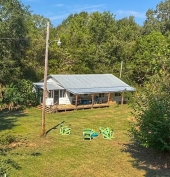posted 1 year ago
I'm presently planning to move from NYC to Iowa sometime this winter. I never thought I would want to return to Iowa, where I grew up. I have at this point lived a large chunk of my life in NYC and most of that time enjoyed all that a dense urban environment offers. However, at this point in my life, for a number of reasons, I'm suddenly anxious to live in the country and grow my own food and live a sustainable lifestyle. And I've realized my best option is to move to the place where I grew up in Iowa. The farm that my family had farmed was sold a few years ago but my parents still live in the house where I grew up and have about 8 acres around it. So I'm planning on bringing my permaculture homestead dreams to the land where I grew up and which has been in the family for 4 generations. I'm planning to move sometime this winter and be settled in before spring so I can start planting.
That said, I have lots of questions as I get started on this journey. I know there are lots of similar posts on these questions, but everything comes with "it depends."
Question 1: I'm planning to put in a vegetable garden and the beginnings of a food forest in an area that is now mowed lawn. I recently did a soil test which showed pH is ideal, and soil is rich in minerals but could use more organic matter. I've already planted 4 fruit trees in the area and can see that the soil is full of earthworms and other soil life. The question is how best to kill off the lawn and prepare the soil for planting. I don't want to kill off the abundant soil life by deep tilling, but I do need to somehow kill off the grass and make the soil workable for planting seeds. My current thinking is laying down a heavy layer of old hay (we have a barn full of hay that is probably 40 years old) over the intended garden area this fall (mid-October). This would hopefully smother most of the lawn and allow the hay to start to break down over the winter, adding organic matter. My thinking is to then lightly till the area in the spring and then mulch around all the new plantings. My main concern is I'd rather avoid tilling as I don't want to destroy soil life, but some tilling may be necessary to remove the lawn and make the area plantable. I know laying down cardboard and putting soil on top of it, or building raised beds are also solutions, though I would like to avoid having to buy large quantities of soil when I already have good soil on site. I plan to also experiment with some Hügelkultur which will definitely involve disturbing the existing soil structure but will be beneficial over the long term.
Question 2: About 2 acres has been leased out over the past few decades for conventional farmland (corn/soybean rotation), with chemical fertilizers and herbicides used. My plan is to plant a cover crop on this area in the spring in order to avoid it all going to weeds, and to build up the soil quality while letting some of the chemicals dissipate. My plan is to seed primarily red clover, with some other soil builders and wildflowers mixed in, and let it rehab for a year at least. How does one best plant a cover crop without using heavy machinery? Do I need to drag a harrow over the area before seeding, after seeding, or both? If I simply broadcast seed by hand or with a mechanical spreader, will enough of the seed be able to grow? The 2-acre field grew soybeans in 2024 and was just harvested in September but will not be leased out next year.
Thanks to anyone who has any insights of either of these 2 issues!








